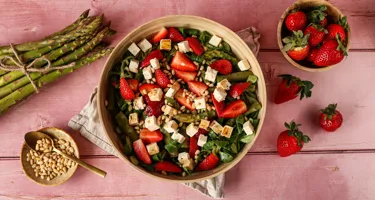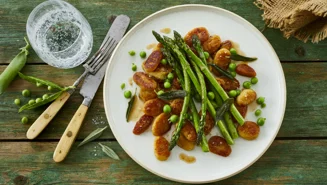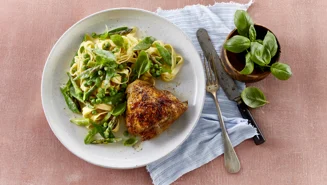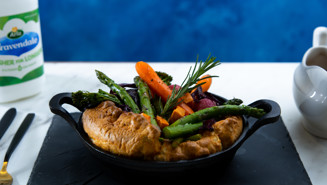
Few vegetables signal the changing seasons quite like asparagus. But with so many varieties popping up throughout the year, knowing when to grab the best bunch and how to keep them fresh is not always easy. That is where we come in!
We have gathered everything you need to know, from the best times to buy them and the right way to store them. If you are keen to expand your knowledge or just want to enjoy the vegetables at its best, we have it all covered.
What is asparagus?
Asparagus is a perennial plant from the Asparagaceae family and is primarily used for cooking. It has been appreciated for its flavour since ancient times. Egyptians, Greeks, and Romans considered it a delicacy, valuing especially its short growing season.
One of the most fascinating things about asparagus is its longevity. A single plant can keep producing spears for up to 20 years, making it well worth growing for those who enjoy long-term harvests. Once mature, the plant can yield 20–25 spears per season, emerging gradually over several weeks each spring.
The plant itself grows from an underground rhizome, sending up tall, sturdy spears that push through the soil in early spring. These spears, which are the part we eat, are harvested when they reach about 20 cm tall and are still tender. Left unpicked, they continue growing into feathery, fern-like plants that can reach over a metre in height before withering in autumn.

When is asparagus in season?
Asparagus is in season primarily in the spring, but the season varies depending on where it grows. The spears are at their best when they are tender and freshly picked. Freshly harvested spears taste far better than those that have spent too long in transit. Once picked, they quickly start losing their natural sweetness and can turn tough, so buying them at their peak guarantees the best quality.
In the following sections, we will look at when to find fresh asparagus in the U.S., Europe, and Asia and how local climates shape the season in each region.
Best times to buy asparagus in different regions
Asparagus season depends on the climate, which means it varies across regions. In Europe, asparagus is a true spring vegetable, with peak season running from March to June, depending on the country.
In the United Kingdom, fresh British asparagus is at its best from late April to late June, with May being the prime month. In Germany, the much-anticipated Spargelzeit brings white asparagus to markets from mid-April to late June. In France, they appear as early as March in the warmer south, while cooler regions continue harvesting into June.
Further south, Spain and Italy see asparagus arriving early, often from February through early summer. In Scandinavia, where the climate is colder, the season starts later than in much of Europe.
Fresh asparagus in Sweden, Norway, and Denmark is typically available from May to late June, with harvest times depending on how mild the spring is. The short growing window makes locally grown asparagus a sought-after ingredient while it lasts.
In the United States, the season varies by region. Warmer states like California, Arizona, and Texas start harvesting as early as February, benefiting from mild winters and early springs. In contrast, northern states such as New York, Michigan, and Washington see peak season from April to June, with some harvests continuing into July in cooler areas. April is often the best month to find fresh ones widely available across the country.
In Asia, the season changes depending on the climate. Countries with temperate weather, like China and Japan, have fresh asparagus from March to May, similar to Europe. In Southeast Asia, where temperatures stay warm year-round, they can be grown and harvested continuously, meaning fresh ones available in markets throughout the year.
How to choose the best asparagus
When buying asparagus, look for firm, straight spears with a smooth surface and no signs of wilting. The tips should be tight and compact, not frayed or starting to flower. Now, let us take a deeper look at how to choose the different types of asparagus.
Green asparagus: the colour should be deep green, sometimes fading to purple near the tips. The stems should feel crisp, not rubbery.
White asparagus: look for smooth, pale spears with no green tinges. If parts of the stalk have turned green, they were exposed to sunlight, which can make them slightly bitter and more fibrous. The best ones are completely pale, with plump, firm stalks and no soft spots or excessive fibrousness.
Avoid asparagus that looks dry, limp, or shrivelled, as this means it has been sitting around too long. Spears with split or mushy ends have lost moisture and will not have the best texture. If the tips appear slimy or give off an unpleasant smell, it is past its prime.

Exploring types of asparagus
Have you ever walked into a shop and wondered what the difference between the types of asparagus really is? Some are green, some are white, and some have a deep purple hue, but what sets them apart? Let us find out.
In the following sections, we explore what makes each type stand out and how they taste. And if you have only ever cooked with one kind, then trust us, there is much more to discover! When you are picking up a bunch at the shop or considering growing your own, knowing the differences will help you select the best ones for the future meals you have in mind.
3 types of asparagus: Green, white, and purple
The way asparagus grows significantly impacts its colour, texture, and taste. Some are exposed to sunlight, turning them bright green, while others are kept underground, staying completely white. Then, there is purple asparagus, which develops its deep colour thanks to natural pigments. These differences also affect how each type tastes and how it is best prepared.
Green asparagus is the most common variety and easiest to find. It has a firm but tender texture. The stalks vary in thickness, with thin spears cooking quickly and thicker ones holding up well to roasting and grilling. Looking for ideas on how to use it? Check out our green asparagus recipes for inspiration.
White asparagus is grown underground, shielded from sunlight, so it never turns green. This gives it a pale, creamy colour. It is usually thicker than green asparagus and has a more delicate texture, though its outer layer can be fibrous and often needs peeling. Because of its thickness, white asparagus is best when boiled or steamed until tender. Want to try it in different dishes? Take a look at our collection of white asparagus recipes.
Purple asparagus is less common but stands out with its beautiful, deep colour. It has a slightly softer texture than the green kind and is best enjoyed raw or lightly cooked to preserve its striking colour. When exposed to too much heat, the purple hue fades, turning green. To keep its vibrant colour, it is best suited for salads, quick sautés, or light steaming.
Now that you know what sets green, white, and purple asparagus apart, you can pick the right ones with confidence. Maybe you stick with the classic green, try the sweeter purple, or see what you can do with the more delicate white spears. Each has its own way of standing out, so why not switch things up and see what you like best?
What does asparagus taste like?
Asparagus has an earthy taste with a slight bitterness. Some compare it to broccoli for its grassy, earthy notes, while others find it similar to artichoke, with a mild nuttiness and a slightly sweet undertone. Its flavour changes depending on the type, but the fresher the asparagus, the more pronounced these natural flavours will be.
Green asparagus has a slightly nutty taste with a balance of natural sweetness and grassy bitterness, which is more noticeable in thicker stalks. The tender tips are usually sweeter.
White asparagus is much milder, with a more delicate sweetness, though it can still have a faint bitterness, especially near the base.
Purple asparagus stands out with its sweeter, almost fruity flavour. It has a hint of natural sugar, making it taste less bitter than the other types. Some compare its mild sweetness to peas or sweetcorn, while the fruitier notes are reminiscent of blackberries or raspberries.
How to store asparagus
Finding the best way to store asparagus is key to keeping it fresh and crisp for as long as possible. The vegetable can spoil quickly if not handled properly, but with the right storage methods, you can extend its freshness in the fridge or freezer.
When you bring asparagus home, handle it carefully to keep its texture intact. The fridge is the best option for short-term storage, where it will stay fresh for 3–5 days. The crisper drawer, which has higher humidity, helps prevent the spears from drying out. For the best results, store them upright in a container with a little water, similar to how you would keep fresh flowers.
Another option is to wrap the ends in a damp paper towel and place the spears inside a loosely closed plastic bag. Both methods help retain moisture and keep the asparagus crisp for longer.
If you have more spears than you can use right away, freezing is a great way to preserve it. Wash the spears and trim the ends before freezing. To help them retain their bright green colour and firm texture, blanch them first by boiling them for 1–2 minutes, depending on their thickness, then immediately plunging them into ice water.
Once cooled, pat them dry and spread them out on a baking sheet to freeze separately. When fully frozen, transfer them to a freezer-safe bag or container. Properly stored, frozen asparagus can last for up to 8 months.

Cooking with asparagus
Once you have picked the freshest asparagus and stored it correctly, the next step is figuring out how to prepare it. You can keep it crisp and bright or cook it until tender, and how you do it changes the flavour completely.
Never cooked asparagus before? Or just looking for a new way to enjoy it? There are plenty of options to try. For a complete overview, check out all of our asparagus recipes—from soups to salads and many more! Some methods draw out its natural sweetness, while others keep that fresh, grassy taste. A quick sauté, a slow roast, or anything in between will all give different results.
No matter how you like it, the right technique makes all the difference. If you want to explore the best ways to prepare asparagus, we have put together a guide with everything from the basics to ideas you might not have tried before.






















&format=webp)




&format=webp)











